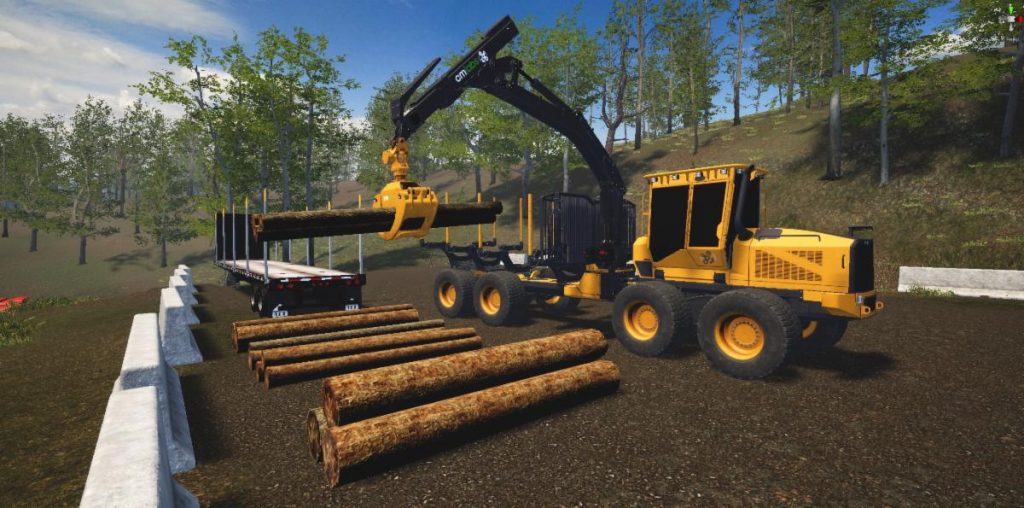
Features
Harvesting
New Gear
Bridging the gap: how simulation training can help attract, retain younger operators
March 4, 2021 By Ellen Cools
 An image of CM Labs' harvester simulator. Photo courtesy CM Labs Simulations.
An image of CM Labs' harvester simulator. Photo courtesy CM Labs Simulations. As anyone in forestry knows, the industry has been staring down the barrel of a skilled labour shortage for years now. And with more logging contractors and machine operators set to retire in the coming years, it’s critical that we address that skills gap.
On February 18, CM Labs Simulations hosted a virtual event focused on training innovations in logging. CM Labs recently announced a partnership with Tigercat, and the launch of its harvester and forwarder simulator training packs. The simulators are designed in collaboration with Tigercat and based on real-life Tigercat machinery.
Presenters at the virtual event highlighted the simulators’ ability to help train students and thereby attract and retain a younger workforce.
Addressing the ‘labour crunch’
In the first session of the day, Drew Carruthers, CM Labs’ director of product management and strategic partnerships, discussed how simulation training can help bridge the skills gap.
“Despite an increase in worker productivity over the years, forestry is dealing with a severe labour crunch as less young people join the industry,” Carruthers shared. Logging, in particular, is facing a labour shortage because it is one of the most dangerous occupations and takes place in a challenging environment.
In order to address the shortage, the industry has launched a concerted effort to develop more formalized recruitment and training. Technology will play a key role in that effort. Simulators, for example, are similar to video games, and give forestry companies the opportunity to go into more urban sectors to attract young people, Carruthers said.
But, recruitment is only one part of the solution. Training also needs to be made more efficient so students can learn faster and feel more comfortable when they begin working on a jobsite. Many young students from urban areas are unlikely to have knowledge of harvesting equipment, so the industry needs to “teach them from the ground up,” Carruthers explained.
Simulators can do this by simulating real-word scenarios, environments and terrains. With simulation training, students will be less stressed because they have experience using equipment controls. It also allows students to “safely fail, which is not something you can do on a real experience,” Carruthers said.
Training also needs to be adapted for the more complex equipment that logging contractors use today.
“Equipment is not a machine anymore – it’s a work office,” he explained. Operators are connected with the mills, transportation and the office, all while sitting in the cab of their machines. Training needs to reflect this real-life situation.
“The next step with training is to make sure that students, when they become operators, are at the market level,” he concluded.
Real-life applications
Mont-Laurier Vocational School, in Mont-Laurier, Que., has seen the benefits of simulation training first-hand. The school has been using CM Labs’ forestry equipment simulators as part of their forestry training curriculum. Mario Leduc, assistant director at the school, shared his experience using the simulators to train students.
The school is currently training 75 students in wood harvesting and another 120 students in forest road building. But, there are multiple challenges in training and recruitment. According to Leduc, the main one is ensuring that students are profitable once they complete their studies and are working in the industry.
To meet this goal, the school, along with program advisors, curriculum developers and government, have to make sure the students have access to the right educational tools. For forestry students, this includes new and innovative machinery, which is extremely expensive, Leduc said.
However, the school cannot train them on old, obsolete machinery. Students need to be trained on harvesters and forwarders that are similar to those currently used by industry, so that they develop the right skills, he explained.
Consequently, the school is constantly buying new equipment – in the past two years alone, they bought six new machines. To help offset these costs and train their students more efficiently, the school purchased CM Labs’ forwarder and harvester simulators.
The school created two classes for the forestry road maintenance group to use the simulators. The technology not only simulates the machine operations, but also the logistics surrounding their use, helping students understand aspects of the job such as whether to dig more in certain situations and the impact of environmental conditions, Leduc shared.
As a result, “students learn about the dangers of their equipment and become more comfortable with basic operations,” he explained.
The benefits of using simulators are obvious: after one week (30 hours) of training on the simulators, students transition to training on the real equipment. Before using the simulators, it would take students a day or two to feel comfortable enough to begin operating. Now, they begin operating within five to 10 minutes, Leduc shared.
“Our teachers and technicians in the field realized one week using simulators was a very big plus for students in terms of their confidence in the machinery, which is very important,” Leduc said.
As a result, the school can maximize its training resources and students will not only pass their classes, but be confident using the machinery, he said.
By using simulators at the start of the class, the school saves the costs associated with running the actual equipment during the first week of training. And because students feel more confident when they begin operating the real machines, this reduces the number of accidents and maintenance costs.
Print this page